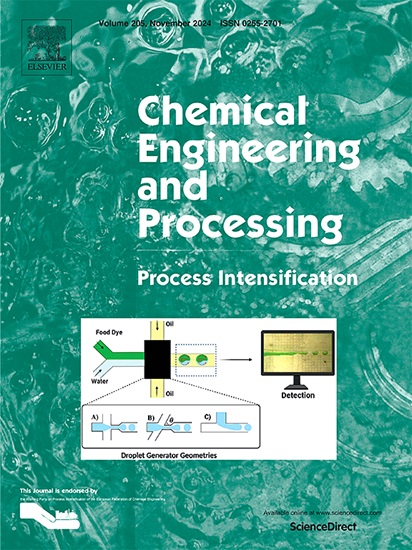Low energy consumption achieved through hydrodynamic mixing of shear-thinning fluids in compact passive micromixers
IF 3.8
3区 工程技术
Q3 ENERGY & FUELS
Chemical Engineering and Processing - Process Intensification
Pub Date : 2025-07-17
DOI:10.1016/j.cep.2025.110453
引用次数: 0
Abstract
This study investigates the mixing performance of compact chaotic microdevices for Newtonian and non-Newtonian Shear-Thinning fluids in microfluidic applications. Building upon the notable mixing characteristics of the Two-Layer Crossing Channels Micromixer (TLCCM-X) with Newtonian fluids, we developed modified designs (TLCCM-KX and TLCCM-O) to enhance mixing efficiency. Numerical simulations were conducted using CFD code to solve Navier-Stokes, mass conservation, and species transport equations. The species transport model was implemented to analyze the mixing process of pseudoplastic carboxymethyl cellulose (CMC) solutions, characterized by the power-law model with flow behavior indices ranging from 0.49 to 1 and generalized Reynolds numbers from 0.2 to 70. Mixing effectiveness was evaluated through hydrodynamic mixing degree calculated across various cross-sectional areas, where a value of 1 represents perfect mixing. Our comprehensive analysis included mass fraction contours, streamlines, shear rate curves, pressure drops, Poiseuille number to the hydrodynamic mixing degree (Po/HMD) ratios, and mixing energy costs. Results demonstrate that the TLCCM-O micromixer exhibits the most energy-efficient device among those studied, requiring significantly lower mixing energy costs. This makes the TLCCM-O particularly promising for applications where energy efficiency is critical considerations, representing advancement in micromixer technology for both Newtonian and non-Newtonian fluid applications.

在紧凑的被动微混合器中,通过剪切稀释流体的流体动力混合实现了低能耗
本文研究了紧凑混沌微器件在牛顿和非牛顿剪切稀化流体中的混合性能。基于双层交叉通道微混合器(TLCCM-X)与牛顿流体的显著混合特性,我们开发了改进设计(TLCCM-KX和TLCCM-O)以提高混合效率。利用CFD代码进行数值模拟,求解Navier-Stokes方程、质量守恒方程和物种输运方程。采用物种输运模型对假塑性羧甲基纤维素溶液的混合过程进行了分析,其特征为幂律模型,流动行为指数为0.49 ~ 1,广义雷诺数为0.2 ~ 70。通过计算不同横截面积的水动力混合度来评价混合效果,其中值为1代表完美混合。我们的综合分析包括质量分数等高线、流线、剪切速率曲线、压降、泊泽维尔数与流体动力混合度(Po/HMD)比以及混合能量成本。结果表明,TLCCM-O微混合器是所有研究中最节能的装置,所需的混合能量成本显著降低。这使得TLCCM-O在能源效率至关重要的应用中特别有前景,代表了牛顿和非牛顿流体应用中微混合器技术的进步。
本文章由计算机程序翻译,如有差异,请以英文原文为准。
求助全文
约1分钟内获得全文
求助全文
来源期刊
CiteScore
7.80
自引率
9.30%
发文量
408
审稿时长
49 days
期刊介绍:
Chemical Engineering and Processing: Process Intensification is intended for practicing researchers in industry and academia, working in the field of Process Engineering and related to the subject of Process Intensification.Articles published in the Journal demonstrate how novel discoveries, developments and theories in the field of Process Engineering and in particular Process Intensification may be used for analysis and design of innovative equipment and processing methods with substantially improved sustainability, efficiency and environmental performance.

 求助内容:
求助内容: 应助结果提醒方式:
应助结果提醒方式:


